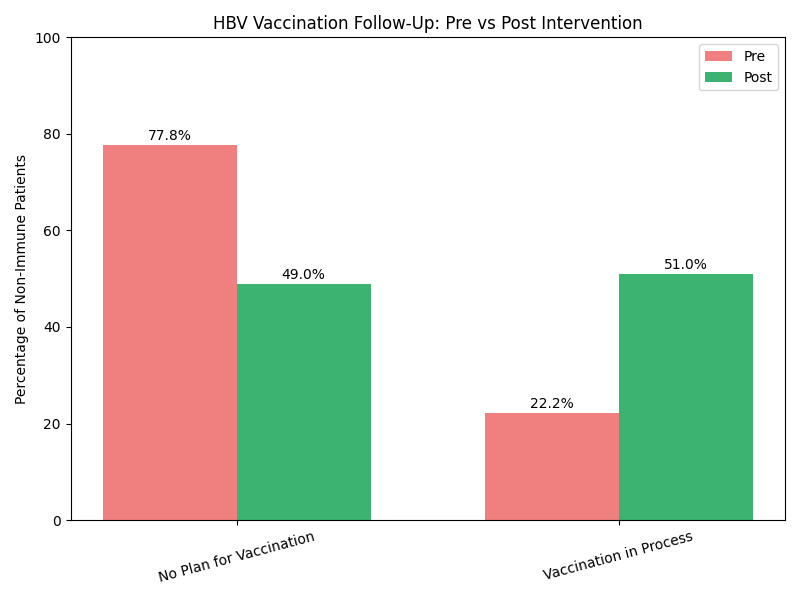Tuesday Poster Session
Category: Liver
P5960 - Improving Hepatitis B Virus Triple Screening and Vaccination Rates Through EMR Smart List and Provider Education in a Resident Primary Care Clinic
Tuesday, October 28, 2025
10:30 AM - 4:00 PM PDT
Location: Exhibit Hall

Michael Bebawy, DO (he/him/his)
Rutgers New Jersey Medical School
Newark, NJ
Presenting Author(s)
Michael Bebawy, DO1, Mahinaz Mohsen, MD1, Rohan Karkra, MBBS1, Menna-Allah Elaskandrany, DO2, Kaveh Hajifathalian, MD1, Ahmed Al-Khazraji, MD1
1Rutgers New Jersey Medical School, Newark, NJ; 2Lenox Hill Hospital, Northwell Health, New York, NY
Introduction: Chronic Hepatitis B Virus (HBV) infection contributes to significant morbidity, particularly among immunocompromised patients. In April 2022, the CDC recommended universal HBV vaccination for adults aged 19–59. In March 2023, this expanded to include triple serologic screening (HBsAg, anti-HBs, anti-HBc). Despite these updated guidelines, adherence remains variable. Prior QA/QI data (Jan 2021 to Jan 2023) showed HBV screening rates as low as 13.86%, with only 8.91% vaccination rates. This QA/QI project aimed to evaluate the impact of EMR smart tools and targeted education on HBV screening and vaccination rates in a resident-run primary care clinic.
Methods: Following the integration of an EMR-based HBV vaccination smart list into the routine health maintenance section and targeted education on updated CDC guidelines, we conducted a retrospective chart review of 100 patients aged 19–59 seen between 4/1/2024 and 4/30/2024. Patients were excluded if they had only one clinic visit. Charts were randomly selected. Data collected included whether HBV triple serology was ordered and completed, immune status, and documentation of vaccination plans for non-immune individuals.
Results: Of the 100 patients reviewed, 97% had HBsAg ordered, 95% completed standard HBV screening, and 85% completed triple serologic screening. Of those screened, 61 patients (72.94%) were non-immune, requiring vaccination. Among non-immune patients, 9 (14.8%) had completed the vaccine series, and 25 (41.1%) were actively undergoing vaccination. However, for 24 patients (39.3%), HBV vaccination had not been addressed. Of these, 9 were documented as “non-immune” and 11 were documented as “Negative” without a plan to address vaccination.
Discussion: HBV screening rates improved substantially following implementation of updated language in EMR smart lists and provider education, increasing from 13.86% to 95%, with 85% completing updated triple serologic screening. HBV vaccination rates also significantly increased from 8.91% to 14% completion, with 41% of patients actively in the process of vaccination. Continued improvement is required and should focus on reinforcing guideline-based language to further improve vaccination rates and ensure appropriate follow-up and vaccination for non-immune patients.

Figure: Figure 1: Demonstrating the change in plan for vaccination pre and post intervention
Disclosures:
Michael Bebawy indicated no relevant financial relationships.
Mahinaz Mohsen indicated no relevant financial relationships.
Rohan Karkra indicated no relevant financial relationships.
Menna-Allah Elaskandrany indicated no relevant financial relationships.
Kaveh Hajifathalian indicated no relevant financial relationships.
Ahmed Al-Khazraji indicated no relevant financial relationships.
Michael Bebawy, DO1, Mahinaz Mohsen, MD1, Rohan Karkra, MBBS1, Menna-Allah Elaskandrany, DO2, Kaveh Hajifathalian, MD1, Ahmed Al-Khazraji, MD1. P5960 - Improving Hepatitis B Virus Triple Screening and Vaccination Rates Through EMR Smart List and Provider Education in a Resident Primary Care Clinic, ACG 2025 Annual Scientific Meeting Abstracts. Phoenix, AZ: American College of Gastroenterology.
1Rutgers New Jersey Medical School, Newark, NJ; 2Lenox Hill Hospital, Northwell Health, New York, NY
Introduction: Chronic Hepatitis B Virus (HBV) infection contributes to significant morbidity, particularly among immunocompromised patients. In April 2022, the CDC recommended universal HBV vaccination for adults aged 19–59. In March 2023, this expanded to include triple serologic screening (HBsAg, anti-HBs, anti-HBc). Despite these updated guidelines, adherence remains variable. Prior QA/QI data (Jan 2021 to Jan 2023) showed HBV screening rates as low as 13.86%, with only 8.91% vaccination rates. This QA/QI project aimed to evaluate the impact of EMR smart tools and targeted education on HBV screening and vaccination rates in a resident-run primary care clinic.
Methods: Following the integration of an EMR-based HBV vaccination smart list into the routine health maintenance section and targeted education on updated CDC guidelines, we conducted a retrospective chart review of 100 patients aged 19–59 seen between 4/1/2024 and 4/30/2024. Patients were excluded if they had only one clinic visit. Charts were randomly selected. Data collected included whether HBV triple serology was ordered and completed, immune status, and documentation of vaccination plans for non-immune individuals.
Results: Of the 100 patients reviewed, 97% had HBsAg ordered, 95% completed standard HBV screening, and 85% completed triple serologic screening. Of those screened, 61 patients (72.94%) were non-immune, requiring vaccination. Among non-immune patients, 9 (14.8%) had completed the vaccine series, and 25 (41.1%) were actively undergoing vaccination. However, for 24 patients (39.3%), HBV vaccination had not been addressed. Of these, 9 were documented as “non-immune” and 11 were documented as “Negative” without a plan to address vaccination.
Discussion: HBV screening rates improved substantially following implementation of updated language in EMR smart lists and provider education, increasing from 13.86% to 95%, with 85% completing updated triple serologic screening. HBV vaccination rates also significantly increased from 8.91% to 14% completion, with 41% of patients actively in the process of vaccination. Continued improvement is required and should focus on reinforcing guideline-based language to further improve vaccination rates and ensure appropriate follow-up and vaccination for non-immune patients.

Figure: Figure 1: Demonstrating the change in plan for vaccination pre and post intervention
Disclosures:
Michael Bebawy indicated no relevant financial relationships.
Mahinaz Mohsen indicated no relevant financial relationships.
Rohan Karkra indicated no relevant financial relationships.
Menna-Allah Elaskandrany indicated no relevant financial relationships.
Kaveh Hajifathalian indicated no relevant financial relationships.
Ahmed Al-Khazraji indicated no relevant financial relationships.
Michael Bebawy, DO1, Mahinaz Mohsen, MD1, Rohan Karkra, MBBS1, Menna-Allah Elaskandrany, DO2, Kaveh Hajifathalian, MD1, Ahmed Al-Khazraji, MD1. P5960 - Improving Hepatitis B Virus Triple Screening and Vaccination Rates Through EMR Smart List and Provider Education in a Resident Primary Care Clinic, ACG 2025 Annual Scientific Meeting Abstracts. Phoenix, AZ: American College of Gastroenterology.

